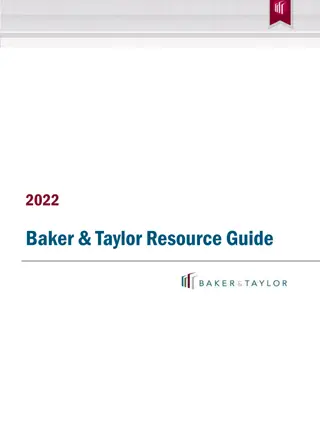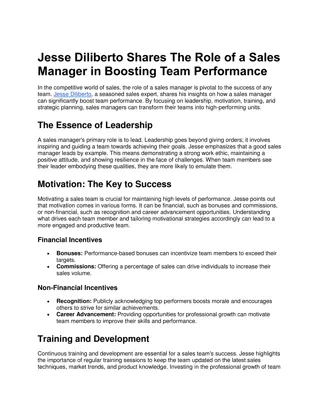
What is Sales Management_ Key Concepts and Best Practices
In the dynamic world of business, driving consistent sales growth remains one of the top challenges. Every company, regardless of size or industry, relies on sales to fuel its operations, scale, and achieve long-term success. Yet, managing sales isn
Download Presentation

Please find below an Image/Link to download the presentation.
The content on the website is provided AS IS for your information and personal use only. It may not be sold, licensed, or shared on other websites without obtaining consent from the author. If you encounter any issues during the download, it is possible that the publisher has removed the file from their server.
You are allowed to download the files provided on this website for personal or commercial use, subject to the condition that they are used lawfully. All files are the property of their respective owners.
The content on the website is provided AS IS for your information and personal use only. It may not be sold, licensed, or shared on other websites without obtaining consent from the author.
E N D
Presentation Transcript
What is Sales Management? Key Concepts and Best Practices Sales management encompasses planning, organizing, directing, and controlling sales activities within an organization. It aims to achieve sales
targets through effective use of resources and strategic planning. Key elements include: Setting Objectives: Establishing clear sales goals for the team. Planning: Developing strategies to meet these objectives, involving market analysis and budgeting. Organizing: Structuring the sales force, assigning territories, and defining roles. Staffing: Recruiting, training, and retaining skilled sales personnel. Directing: Implementing sales plans and motivating the team. Controlling: Monitoring performance, analyzing results, and making adjustments. Importance of Sales Management in Business Sales management is vital for maximizing revenue and ensuring business growth. Effective sales management provides: Clear Direction: It helps define sales goals and align them with overall business objectives. Enhanced Team Performance: Sales managers develop and motivate their teams, ensuring high productivity. Efficient Resource Allocation: It optimizes resource use, from budgets to personnel, ensuring maximum returns. Market Insight: Sales management leverages market data to improve product positioning and sales tactics. Customer Relationship Management: It fosters strong customer relationships, enhancing customer satisfaction and loyalty. Performance Monitoring: It offers continuous monitoring and adjustment of sales strategies for optimal outcomes.
Core Responsibilities of a Sales Manager A Sales Manager is tasked with several critical duties to drive team success and revenue growth: Team Leadership: Leads and motivates the sales team, fostering a positive environment. Goal Setting: Establishes sales targets and individual quotas. Performance Monitoring: Tracks performance metrics and provides feedback. Training and Development: Conducts training sessions to enhance skills and strategies. Strategy Development: Creates and implements sales strategies aligned with company goals. Customer Relationship Management: Manages key accounts and improves customer satisfaction. Sales Forecasting: Prepares sales reports, and forecasts future sales trends, and budgets. Market Analysis: Analyzes market trends and adapts strategies accordingly. Key Skills Required for Effective Sales Management Effective sales management necessitates a unique blend of skills that drive sales teams toward achieving goals. Key skills include: 1. Leadership: Ability to inspire and motivate the team. 2. Communication: Proficiency in clear, persuasive communication. 3. Strategic Thinking: Developing long-term strategies aligning with business objectives. 4. Analytical Skills: Interpreting sales data to optimize strategies.
5. Coaching: Training and mentoring team members for skill enhancement. 6. Negotiation: Encouraging favorable outcomes in sales deals. 7. Adaptability: Adjusting to market changes quickly and efficiently. 8. Time Management: Prioritizing tasks to meet deadlines effectively. Managers must integrate these skills to lead teams successfully. Process of Sales Management The sales management process involves several key stages that ensure the effectiveness of the sales team. 1. Recruiting and Hiring: Identifying, interviewing, and selecting the right sales personnel. 2. Training: Providing new hires with necessary skills and company knowledge. 3. Setting Goals: Establishing clear, attainable sales targets. 4. Performance Monitoring: Tracking sales activities and outcomes. 5. Motivating: Implementing incentive programs to drive productivity. 6. Coaching: Offering ongoing support and development. 7. Reporting: Using data and analytics to guide strategy. 8. Feedback: Regularly reviewing performance and providing constructive feedback. This systematic approach helps maintain a high-performing sales force. Building a Successful Sales Team Constructing a high-performing sales team is essential for achieving business goals. Key steps include: 1. Recruitment: Hire candidates with the right skills and cultural fit. 2. Training: Provide ongoing training on products, sales techniques, and CRM tools.
3. Incentives: Implement robust incentive programs to motivate and retain top talent. 4. Metrics: Establish clear performance metrics to track individual and team success. 5. Technology: Equip the team with advanced sales tools and software. 6. Communication: Foster open communication channels to address challenges and share successes. 7. Leadership: Ensure strong leadership to mentor and guide the sales team. Setting Sales Objectives and Goals Effective sales management begins with setting clear, measurable objectives and goals. These targets define what the sales team should achieve within a specific timeframe. Sales objectives can include: Revenue Targets: Specific monetary goals to boost the company s income. Sales Volume: Number of units sold within a period. Market Penetration: Increasing market share by acquiring new customers. Profit Margins: Aimed at enhancing profitability per sale. Objectives should be: SMART: Specific, Measurable, Achievable, Relevant, and Time-bound. Aligned with Business Strategy: Reflect the overall mission and vision. Sales Planning and Strategy Development Sales planning and strategy development are fundamental to effective sales management:
1. Market Analysis: Conduct thorough market research to understand industry trends, customer needs, and competitive landscape. 2. Target Setting: Set realistic, measurable sales targets aligned with business goals. 3. Sales Process Design: Define clear, efficient sales processes tailored to the target market and product/service offerings. 4. Resource Allocation: Allocate resources strategically, ensuring sales teams have the tools and support they need. 5. Performance Metrics: Identify key performance indicators (KPIs) to track progress and drive continuous improvement. 6. Training Programs: Implement ongoing training to enhance sales skills and product knowledge. 7. Customer Relationship Management: Utilize CRM systems for effective customer data management and personalized engagement. Effective planning and strategic development ensure sustainable growth and competitive advantage. Sales Forecasting Techniques Sales forecasting is essential for predicting future revenues and setting realistic targets. Techniques include: Historical Analysis: Examines past sales data to identify trends. Market Research: Uses surveys and industry reports to gauge demand. Sales Funnel Analysis: Evaluates prospects at different stages. Regression Analysis: Explores relationships between variables. Time-Series Analysis: Projects future sales based on historical trends. Scenario Planning: Considers different market scenarios. Each technique offers insights that aid in making informed decisions. Proper use of these methods enhances accuracy, leading to better resource allocation and strategic planning.
Performance Metrics in Sales Management Performance metrics in sales management are essential for assessing productivity and effectiveness. Common metrics include: Sales Revenue: Measures total income from sales. Conversion Rate: Percentage of leads that turn into customers. Customer Acquisition Cost: Expense to gain a new customer. Average Deal Size: Typical revenue from closed deals. Sales Cycle Length: Time taken to close a deal. Lead Response Time: Speed of initial response to a lead. Sales per Rep: Revenue generated by individual sales representatives. Churn Rate: Percentage of customers who stop using the service/product. Monitoring these metrics aids in strategic decision-making and optimizing sales processes. Sales Training and Development Programs Sales training and development programs are crucial to enhance team competence and drive success. Effective programs should focus on: Product Knowledge: Understanding product features and benefits. Sales Techniques: Mastering strategies such as SPIN selling or consultative selling. CRM Systems: Proficiency in using software tools to manage customer relationships. Negotiation Skills: Techniques for successful deal closure.
Communication Skills: Clear and persuasive verbal and written communication. Role-playing Exercises: Simulating sales scenarios for practical experience. Ongoing Support: Continuous learning through workshops and feedback sessions. Implementing structured programs ensures sales professionals remain competitive and adept in a dynamic market. Utilizing Technology in Sales Management Sales managers integrate technology to streamline processes and enhance team efficiency. Customer Relationship Management (CRM) systems manage customer interactions, track sales, and analyze data. Key Technologies 1. CRM Systems Centralize customer data Enhance communication Track sales performances 2. Sales Analytics Tools Provide insights into sales trends Identify high-performing strategies Forecast future sales 3. Automation Software Automate routine tasks Improve lead management Increase team productivity 4. Communication Platforms Facilitate team collaboration Conduct virtual meetings
Share real-time updates Client Relationship Management Client relationship management (CRM) focuses on nurturing and maintaining long-term client relationships. Effective CRM involves: Understanding Client Needs: Regularly assess and address specific client requirements. Personalization: Tailor communication and offerings to meet individual client preferences. Consistency: Maintain consistent quality and timely interactions. Feedback Mechanisms: Implement channels for clients to provide feedback and suggestions. Client Data Analysis: Utilize data analytics to understand client behavior and predict future needs. Trust Building: Establish trust through transparency and reliability. Proactive Communication: Engage clients regularly beyond transactional interactions. Strong client relationship management leads to increased client satisfaction and loyalty. Addressing Challenges in Sales Management Sales managers often face numerous challenges that can hinder team performance and goal achievement. Common Challenges 1. Talent Acquisition and Retention Recruiting skilled salespeople Maintaining low turnover rates
2. Performance Assessment Developing effective KPIs Conducting unbiased evaluations 3. Market Adaptability Responding to market changes Adjusting strategies accordingly 4. Technological Integration Implementing CRM systems Training staff on new tools Effective solutions involve continuous training, clear communication, and leveraging data analytics. Best Practices for Effective Sales Management Set Clear Goals: Sales managers should establish specific, measurable, attainable, relevant, and time-bound (SMART) objectives. Regular Training: Continuous training programs enhance the skills and product knowledge of the sales team. Use of CRM Systems: Implementing Customer Relationship Management systems helps track interactions and manage sales pipelines efficiently. Motivational Incentives: Offering performance-based incentives such as bonuses and recognition boosts motivation and performance. Data-Driven Decisions: Utilizing data analytics for decision-making improves forecasting and strategy formulation. Effective Communication: Regular meetings and feedback sessions keep the team aligned with goals. Customer-Centric Approach: Prioritizing customer needs and feedback fosters trust and satisfaction. Future Trends in Sales Management
Emerging trends are reshaping sales management, demanding adaptation and agility. Key Future Trends 1. AI and Automation: AI algorithms help in predictive analytics, lead scoring, and customer relationship management. 2. Data-Driven Decisions: Enhanced use of big data ensures informed decision-making processes. 3. Remote Selling: Increased reliance on virtual sales techniques and online client interactions. 4. Customer-Centric Models: Emphasis on delivering personalized customer experiences. 5. Interdepartmental Collaboration: Integration of sales with marketing, finance, and customer service. 6. Sales Enablement Tools: Adoption of software solutions to streamline sales activities. Key Takeaways Sales management is crucial for driving business growth, involving strategic planning, team leadership, and data-driven decision-making. It prioritizes aligning sales efforts with company goals, optimizing sales processes, and fostering a customer-centric culture. Roles and Responsibilities: Goal setting Sales forecasting Performance tracking Best Practices: Effective communication Regular training Use of technology and CRM tools Key Concepts: Sales pipeline management
Customer relationship building Market analysis A successful sales manager integrates these elements to create a motivated, efficient, and high-performing sales team.






















